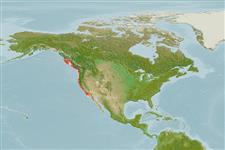>
Ovalentaria/misc (Various families in series Ovalentaria) >
Embiotocidae (Surfperches)
Etymology: Hyperprosopon: Greek, hyper = over + Greek, prosopon = face, snout of animal (Ref. 45335); ellipticum: From the Latin 'ellipticum' - referring to the outline of the body (Ref. 6885).
Environment: milieu / climate zone / depth range / distribution range
Ecologie
marien demersaal; diepte 0 - 110 m (Ref. 2850). Subtropical; 56°N - 30°N, 135°W - 116°W
Eastern Pacific: southern British Columbia, Canada to Rio San Vincente, northern Baja California, Mexico.
Grootte / Gewicht / Leeftijd
Maturity: Lm ? range ? - ? cm
Max length : 27.0 cm TL mannelijk / geslacht onbekend; (Ref. 2850); max. gerapporteerde leeftijd: 7 Jaren (Ref. 56049)
Korte beschrijving
Determinatiesleutels | Morfologie | Morfometrie
Dorsale stekels (totaal) : 8 - 10; Dorsale zachte stralen (totaal) : 25 - 28; Anale stekels: 3; Anale zachte stralen: 29 - 34. Dark green dorsally, sides and belly silvery; a series of narrow vertical bars of pale golden pink on body wall; pectoral fins colorless (Ref. 6885). British Columbia specimens dark on end of caudal fin and free edge of spinous dorsal (Ref. 6885).
Found inshore, in surf and sandy areas, also occur around rocks and piers (Ref. 2850). Intertidal and to 110 m (Ref. 96339). Viviparous, female carries the developing young (Ref. 205). Frequently caught, but not of much importance as a sport fish due to its small size (Ref. 2850).
Viviparous, female carries the developing young (Ref. 205).
Eschmeyer, W.N., E.S. Herald and H. Hammann, 1983. A field guide to Pacific coast fishes of North America. Boston (MA, USA): Houghton Mifflin Company. xii+336 p. (Ref. 2850)
Status op de Rode Lijst van het IUCN (Ref. 130435: Version 2024-2)
Gevaar voor de mens
Harmless
Gebruik door de mens
Visserij: commercieel; sportvis: ja; Aquarium: Publieke aquaria
Tools
Speciale rapporten
Download XML
Internetbronnen
Estimates based on models
Preferred temperature (Ref.
123201): 8.3 - 12.8, mean 9.8 °C (based on 64 cells).
Fylogenetische diversiteitsindex (Ref.
82804): PD
50 = 0.6250 [Uniqueness, from 0.5 = low to 2.0 = high].
Bayesian length-weight: a=0.01905 (0.00827 - 0.04391), b=2.97 (2.77 - 3.17), in cm total length, based on LWR estimates for this (Sub)family-body shape (Ref.
93245).
Trofisch niveau (Ref.
69278): 3.3 ±0.5 se; based on size and trophs of closest relatives
Weerstandsvermogen (Ref.
120179): Gemiddeld, minimale populatieverdubbelingstijd 1,4-4,4 jaar (tm=3; tmax=7).
Fishing Vulnerability (Ref.
59153): Low vulnerability (17 of 100).
